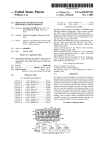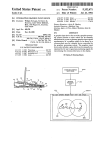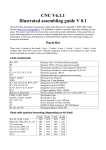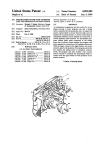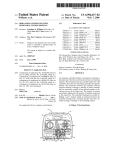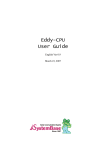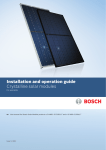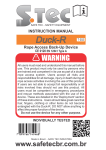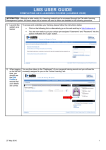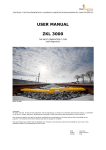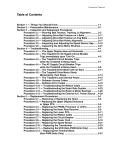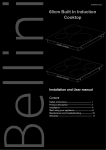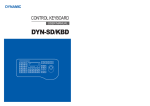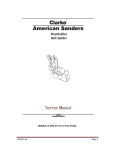Download Irrigation controller with removable station modules
Transcript
US005956248A Ulllted States Patent [19] [11] Patent Number: Williams et al. [45] [54] IRRIGATION CONTROLLER WITH [56] REMOVABLE STATION MODULES [75] Sep. 21, 1999 References Cited U_s_ PATENT DOCUMENTS Inventors; Jonathan D_ Williams, Riverside; Peter M. F. Tam, Irvine, both of Calif. Date of Patent: 5,956,248 5,479,338 12/1995 Erickson et a1. ...................... .. 364/145 Primary Examiner_w?liam Grant Assistant Examiner—McDieunel Marc [73] Assignee: The Tom Company, Minneapolis, Mmn' Attorney, Agent, or Firm—]ames W. Miller [57] ABSTRACT [21] Appl, No; 08/904,125 An irrigation controller includes a housing for enclosing a [22] Filed: program. The microprocessor has a parallel output bus With a plurality of pin sets for controlling a plurality of irrigation stations. The connection between the controller and the irrigation stations is through a plurality of station modules that are removably coupled, in any desired number, to the microprocessor that stores and executes at least one Watering Jul. 28, 1997 Related US. Application Data [63] Continuation of application No. 08/312,268, Sep. 23, 1994, [51] abandoned Int. Cl? ................................................... .. G05B 11/01 [52] US. Cl. ............. .. 364/145; 364/528.18; 364/528.19; 364/188; 239/69; 239/70; 239/99 _ Fleld of Search .......................... .. 364/188, 189, 528.18, 528.19, 239/63, 67—70, 69,723,722, 68, 99, 137/624.11—624.2 various pin sets on the output bus. The number of stations Controlled is adjusted by the number of modules Connected to the output bus. The controller housing has a pocket for ~ - holding a user , s manual, Which is positioned betWeen the . . controller housing and a mounting bracket When the con troller housing is installed on the mounting bracket' 18 Claims, 5 Drawing Sheets U.S. Patent Sep.21, 1999 Sheet 1 of5 5,956,248 //////§///‘///\[///|//(////// U.S. Patent Sep.21, 1999 Sheet 3 of5 5,956,248 5FI'E- U.S. Patent Sep.21, 1999 Sheet 4 of5 FIE. 7 FIE’. 5' 3113.5 5,956,248 U.S. Patent Sep.21, 1999 Sheet 5 of5 5,956,248 I I I I I I I I I I I I I I I I I I I I I I I I II I I I I I I g m 5,956,248 1 2 FIG. 2 is a side elevational vieW of the controller shoWn IRRIGATION CONTROLLER WITH REMOVABLE STATION MODULES in FIG. 1, particularly illustrating the controller housing and its attachment to a mounting bracket on Which the controller housing is removably installed; This application is a continuation of application Ser. No. 08/312,268, ?led Sep. 23, 1994, noW abandoned. FIG. 3 is a top plan vieW of the controller shoWn in FIG. 1, particularly illustrating the controller housing and its TECHNICAL FIELD mounting bracket; FIG. 4 is a bottom plan vieW of the controller shoWn in This invention relates to an irrigation controller for con trolling the operation of an irrigation system pursuant to a Watering schedule that may be programmed by the user. More particularly, this invention relates to an irrigation FIG. 1 With the controller housing in place on its mounting 10 FIG. 5 is an exploded, rear elevational vieW of the controller for controlling multiple irrigation stations. BACKGROUND OF THE INVENTION 15 Irrigation controllers are knoWn for controlling the opera tion of an irrigation system in accordance With the passage of time. Most controllers operate a plurality of Watering to be stored. 25 expanded by plugging in additional modules With each DETAILED DESCRIPTION This invention relates to an irrigation controller 2 for controlling the operation of an irrigation system in a timed part of a serial bus structure in the controller. The modules manner. More speci?cally, controller 2 alloWs the user to knoWn in this prior controller are quite large and When 35 erable space exteriorly of the base unit, leading to problems folloWing parameters of irrigation system operation: WindoW (i.e. a calendar sequence) or the interval betWeen successive operational days up to a maximum ing all of the modules in a secure fashion. interval of 7 days (i.e. an interval sequence), the operational days being knoWn as “active days”; SUMMARY OF THE INVENTION This invention relates to an irrigation controller Which When the sprinklers come on during the active days, knoWn as the “start times”, With up to four start times being selectable; and 45 plurality of separate station output pins for controlling the irrigation stations With one station output pin used for controlling each station. At least one module is removably hoW long the sprinklers Will run after each start, knoWn as the “run times”. Controller 2 is adapted to control a plurality of separate Watering “stations” in the irrigation system. Each station comprises one or more sprinklers grouped together to oper ate simultaneously off the same irrigation valve V. Each plugged into at least one of the station output pins on the output bus. The module has a terminal suited for receiving an electrical lead Wire extending to the irrigation station, and further has driver and sWitch means for activating the station irrigation valve V includes an actuator, such as an electrical solenoid S, Which is operated by a control signal from controller 2 to turn valve V on. as commanded by the base unit over the at least one station BRIEF DESCRIPTION OF THE DRAWINGS select or input at least one Watering program comprising the Which days the sprinklers Will operate in a particular 7 day in ?nding sufficient space to receive them all and in attach output pin. installed in the controller of FIG. 1; FIG. 8 is a partial front elevational vieW of the controller shoWn in FIG. 1, With the terminal strip cover being removed to shoW tWo station modules for controlling four irrigation stations and the rain sensor, 24 V AC and pump a common outputs contained on the terminal strip; and FIG. 9 is a schematic diagram of one of the station modules used in the controller of FIG. 1. module having drivers and sWitches for an additional num ber of stations. The modules When connected extend and are comprises a housing having microprocessor means for stor ing and executing a Watering program for controlling a plurality of irrigation stations. The microprocessor means includes a parallel output bus Within the housing having a holding a user manual for the controller; FIG. 6 is an enlarged front elevational vieW of one of the station modules of the controller With the module shoWn FIG. 6, particularly illustrating hoW the station module is pick What days the sprinklers Will operate, What time of day that irrigation Will begin, and hoW long each station Will operate. Some controllers alloW multiple Watering programs connected to the base unit of the controller take up consid controller shoWn in FIG. 1, particularly illustrating the controller housing detached from the mounting bracket and the pocket provided on the back of the controller housing for installed in the controller of FIG. 1; FIG. 7 is a cross-sectional vieW taken along lines 7—7 of stations and Will retain or store a Watering program estab lished by the user. This program typically alloWs the user to US. Pat. No. 5,262,936 discloses a microprocessor based controller in Which the controller base unit has drivers and sWitches for controlling some number of irrigation stations that is less than the maximum number that can be controlled. The station handling ability of the controller can be bracket; 55 Controller 2 of this invention can be easily adapted to control different numbers of stations up to a total of eight stations. A four station controller 2 is illustrated in this application. Referring to FIG. 8, the four stations are illus This invention Will be described in more detail in the trated by the four separate irrigation valves V1, V2, V3 and folloWing Detailed Description, taken in conjunction With V4 Wired to controller 2. There Will be six irrigation valves V1—V6 Wired to controller 2 in a six station controller, eight valves V1—V8 in an eight station controller, and so on. While eight is the maximum number of stations that can be the folloWing draWings, in Which like reference numerals refer to like elements throughout. FIG. 1 is a front elevational vieW of an improved irriga tion controller according to this invention, particularly illus trating the controller housing and front panel With its asso ciated controls and displays and having a portion of the controller broken aWay to illustrate one of the removable station modules installed inside the controller housing; controlled by controller 2 shoWn herein, the maximum number of stations can obviously be adjusted to a larger 65 number if so desired. For each Watering program stored in controller 2, a run time may be set individually for each separate station, i.e. 5,956,248 3 4 different stations may have different run times depending on snap onto and off of controller housing 4 using knoWn tab operator preference. However, the selections of active days and slot connections. Terminal area 16 includes space for and start times apply to all stations as a group Within each Watering program. Thus, When an active day and start time is reached When executing a particular Watering program, three, terminal blocks 20a, 20b, and 20c Which are hard Wired into place. In addition, terminal area 16 includes space for up to four, tWo-station modules 22a, 22b, etc. that are controller 2 Will operate the irrigation system by sequencing used to connect controller 2 to the irrigation stations com through the stations and operating each station for the run time Which has been set for that station on that particular prising valves V. Station modules 22 are generally identical program. Sequential operation of the stations is preferred to 2—modules 22 simply plug into controller 2 and can be easily unplugged from controller 2 in a manner to be decrease the demands on the Water delivery capacity of the to one another and are easily removable from controller 10 irrigation system. described shortly, Controller 2 incorporates a microprocessor (not shoWn) of Terminal blocks 20 and station modules 22 each have tWo any suitable design Which comprises a timing, memory, logic and control means. The microprocessor monitors the passage of time and executes Whatever Watering program has been input and selected by the user for execution. snap-in Wire terminals 24a, 24b therein for receiving tWo 15 Operational ?exibility is achieved by alloWing controller 2 connecting Wires. Such terminals are Well knoWn in the electrical connection art. They each have a pivotal lever 26 that may be rotated 90° from an open position (Where lever 26 is vertical and the Wire may be inserted into the terminal) to a generally closed position (Where lever 26 is horiZontal and the Wire is clamped or retained in the terminal). The use to store and execute multiple Watering programs so that a different combination of active days, start times, and run times can be stored in different programs if so desired. The 20 microprocessor can also permanently store a default Water ing program for use if the user fails to input a customiZed Watering program or programs of the user’s oWn design. Typical irrigation controllers based on the use of micro processors are disclosed in US. Pat. Nos. 5,262,936 and 25 5,272,620, oWned by the assignee of this application. These patents are hereby incorporated by reference. of such snap-in Wire terminals is preferred as it eases the task of connecting the necessary Wires to controller 2. Other quick coupling devices could be used, or conventional screW type terminals could be used, in place of snap-in terminals 24a, 24b. The nature of the Wires that are connected to the various more detail hereafter, housing 4 may be mounted on a Wall terminal blocks 20 and station modules 22 Will vary. For example, the ?rst terminal block 20a connects to the tWo lead Wires of a rain sWitch (not shoWn) Which determines if it is raining and alloWs controller 2 to cease operation in the case of rain. A typical rain sWitch of the type Which may be connected to terminal block 20a is described in US. Pat. No. 5 using a mounting bracket 6. Housing 4 includes a front 5,101,083, Which is hereby incorporated by reference. An panel 8 having various operational controls Which may be on/off sWitch 28 can be mounted in terminal area 16 imme diately above terminal block 20a for the rain sWitch. In the Referring to FIG. 1, the electronic components of con troller 2, including the microprocessor, are contained Within a housing 4 of any suitable design. As Will be described in manipulated by the user to activate control functions of controller 2 or to input information into controller 2. In addition, controller 2 includes a display device 10 for 30 35 off position of sWitch 28, the rain sWitch input is ignored by controller 2 such that the detection of rain Will not affect the operation of controller 2 or the irrigation system. displaying information to the user. The operational controls of controller 2 include a rotary The second terminal block 20b is used for the convenient knob or dial 12 for selecting various ones of the program mable parameters that can be input and stored in a Watering connection of an external electrical transformer 30 used to 40 program, and various push button controls identi?ed gener ally as 14. Push button controls 14 include “up/doWn” or 120 V AC poWer, and Will provide 24 V AC poWer to controller 2. Ultimately, such 24 V AC poWer Will be used to activate solenoids S on irrigation valves V. Additionally, “plus/minus” keys 14a, 14b for incrementing or decrement ing the value of a particular parameter When programming the controller, an “enter” key 14c for accepting a particular value of a parameter and for proceeding to the next step in the programming sequence, and an “escape” key 14d to start provide AC poWer to controller 2. Transformer 30 Will be Wired or plugged into a standard AC poWer source such as 45 such poWer can be routed through one of the terminals in terminal block 20c to activate a solenoid S on a master valve over during programming. Thus, by rotating dial 12 to a or a relay on an irrigation pump. This is required in irrigation systems Where a source of pressuriZed Water is not continu particular position corresponding to a particular parameter ally present upstream of valves V, but is provided only When that can be input, the user can then manipulate controls 14 50 irrigation is to take place. In this event, either a master valve to input and store values for the selected parameter While supplying valves V must ?rst be opened, or a pump started, to ensure supply of pressuriZed Water to valves V. observing in display device 10 the values as they are being input for that parameter through the operation of controls 14. The type of Watering program stored in controller 2, namely the number and nature of the parameters that can be set and stored in a Watering program and then executed by controller 2, can obviously be varied. In addition, the nature The third terminal block 20c as noted above uses one of 55 24b in terminal block 20c is used as a common Wire of the operational controls 12, 14 used to input the Watering program or access the features of controller 2 can also obviously be changed. This invention relates to other fea tures of controller 2, to be described in detail hereafter, that the snap-in terminals, namely terminal 24a, as a master valve or pump relay output for supplying 24 V AC poWer from controller 2 to these components. The other terminal 60 connection COM to ground. Thus, all of the common Wires for all of the irrigation valves V may be spliced together, as shoWn in FIG. 8, and connected to ground using the common Wire terminal 24b in terminal block 20c. In addition, When can be used generally on any irrigation controller that controls a plurality of stations, Without being limited to operating a master valve or pump, the common Wire for such master valve or pump may also be spliced into and con controller 2 as shoWn herein. nected to the common Wire connection COM leading to A loWer portion of controller 2 houses an input/output 65 common Wire terminal 24b. Station modules 22 are used to alloW controller 2 to terminal area, identi?ed generally as 16, behind an easily removable access strip or panel 18. Panel 18 is con?gured to control a desired number of stations determined by the 5,956,248 5 6 number of modules 22 that are installed. Each module 22 has front, in effect being supported in the manner of a cantilever. This section 60 Will have a natural outWard biasing force Which tends to keep this section 60 aligned With the remain ing portions of the top Wall of module 22. The rear of section 60 is provided With an upWardly protruding hook 62. Hook 62 is adapted to engage against the rear side of a vertical Wall 64 that overlies the inner end of slot 44. As module 22 is slid into place in a slot 44 (after it has tWo snap-in terminals 24a, 24b for controlling tWo stations, With each terminal being connected to the non-common Wire lead from a solenoid S. Amodule 22 could be used to control only one station if only of the snap-in Wire terminals 24a, 24b is connected to a single solenoid. HoWever, if both terminals are being utiliZed, then each module 22 Will control tWo stations, ie two of the irrigation valves V. See FIG. 8. Controller 2 is provided With means for accepting up to a predetermined maXimum number of modules 22 to control up to a predetermined maXimum number of stations V. There is space in controller 2 for accepting up to four modules 22 10 been dropped into place in slot 44 With guide tabs 54 ready to be pushed beneath lips 52), hook 62 Will be cammed doWn beneath Wall 64 With the cut aWay top Wall section 60 de?ecting doWn as necessary to alloW this movement. When hook 62 clears Wall 64 as module 22 plugs into the pin set 40 on output bus, the cut aWay section 60 of the top Wall 5 5 Will spring back upWardly to its normal untensioned state side-by-side in terminal area 16, thus alloWing up to eight stations to be controlled. If one module 22 is installed, then 15 Where it is generally aligned With the remainder of the top up to tWo stations can be controlled, With tWo modules 22 up Wall. Thus, hook 62 and cut aWay section 60 of the top to four stations can be controlled, and so on. FIG. 8 module Wall form, in effect, a spring biased latch for ?rmly locking module 22 in place in slot 44. illustrates a con?guration having tWo modules installed controlling four stations represented by the four irrigation valves V1—V4. Referring to FIGS. 1, 6 and 7, each station module 22 To remove any particular module from its slot 44, the user simply presses doWn on the cut aWay section 60 of the top Wall to disengage hook 62 from behind Wall 64, and then includes a casing 32 having a generally rectangular base 34 secured to a tapered top 36. Base 34 and top 36 may be separable to alloW a printed circuit board to be inserted into module 22 during manufacture, With base 34 and top 36 then being snapped together and held as a unit by suitable 25 Thus, the actions required to remove a module 22 are the reverse of those used to install module 22. connectors 38. One end of module 22 includes the tWo snap-in Wire terminals 24a, 24b representing the output end The electronic circuitry for activating the solenoid S on the valves V is contained on the printed circuit board that is carried Within each module 22. Referring to FIG. 9, this circuitry comprises a transistor driver 70 for activating a of module 22. The other or input end of module 22 has a plug connection for alloWing module 22 to be plugged into one set 40 of four output pins 42 on a parallel output bus in controller 2. In each set 40 of pins 42, one pin is assigned to TRIAC sWitching device 72. Each terminal 24a, 24b is control one of the terminals 24a and 24b, respectively, another pin is a ground connection, and the remaining pin is a 5 V poWer input to module 22. See FIG. 9. Thus, When connected to its oWn transistor/TRIAC combination 70/72. Thus, When controller 2 determines that a particular valve V 35 module 22 is in place and is plugged into the parallel output bus, controller 2 Will activate the stations connected to module 22 as called for by the Watering program being Terminal area 16 of controller 2 is provided With four slots 44 in Which modules 22 are slidably received, With one slot particular irrigation system. In addition, modules 22 are all 45 conveniently located Within, and protected by, housing 4 of controller 2. Thus, controller 2 is compact and not unduly bulky. The bottom of controller housing 4 includes various ports or openings 80 for routing Wires to and from terminal ing lips 52 on either side thereof Which are spaced from one another and are elevated above the upper aligned surfaces 48 of Walls 50. Lips 52 are suited to slidably engage With a area 16 for connection to terminal blocks 20 or station plurality of guide tabs 54 that jut out from the sides of modules 22 to guide modules 22 in slots 44. As shoWn most clearly in FIG. 7, to insert a module 22 into one of the slots 44 in terminal area 16, module 22 is positioned as shoWn in phantom above slot 44 and With guide laitabs 54 on modules 22 being located in the gaps should be opened, it does so by activating the appropriate transistor 70 to close the appropriate TRIAC 74, thus activating the solenoid of the appropriate valve. The use of plug in, removable station modules 22 for serving as the connection to the irrigation stations alloWs controller 2 to have great versatility. If only a four station controller is needed, only tWo modules 22 need be used. Thus, the user can tailor controller 2 to control precisely only those numbers of stations that are required for a executed by controller 2. 44 being provided for each module 22. Each slot 44 is formed by the upper aligned surfaces 48 of a plurality of spaced vertical Walls 50 in terminal area 16, such surfaces 48 de?ning a plane against Which the bottom of module 22 may be engaged. Each slot 44 further has tWo spaced overhang pulls slightly outWardly on module 22 to clear guide tabs 54 from beneath lips 54 and to unplug module 22 from the output bus. Module 22 is then simply lifted up out of slot 44. modules 22. See FIG. 4. The Applicants have found that controller 2 Will have great resistance to lightning strikes that may induce surge currents on the station Wires. In previous controllers, the energy from such a strike Will often be conducted back to aligned surfaces 48 of vertical Walls 50. Module 22 is then controller 2 along the Wires connecting controller 2 to the particular station affected by the strike. Since these Wires are usually connected directly to a terminal strip that is hard Wired to the main printed circuit board of controller 2, ie to pushed inWardly in slot 44 relative to the parallel output bus the circuit board having the microprocessor controller, this 55 betWeen the spaced lips 52. Module 22 is then dropped doWnWardly until 20 the bottom thereof rests on the upper until the pin set 50 on the bus plugs into the connector provided therefor in the input end of module 22 as shoWn in solid lines in FIG. 7. In this position, guide tabs 54 on module 22 have slid beneath lips 52 on the sides of slots 44. The top of each module is provided With means forming a spring biased latch. More speci?cally, this latch is provided by a section 60 of the top Wall of module 22 that is cut aWay along its sides and rear but is joined to module 22 at the energy could often damage many of the controller’s components, including the microprocessor. HoWever, With modules 22 of the present invention, Applicants have found that much of the energy from a 65 lightning strike Will be absorbed by the electronic circuitry Within module 22 Without damaging the main printed circuit board in controller 2. Thus, While module 22 itself may be destroyed by the lightning strike, it is a simple matter to 5,956,248 8 7 replace this module With a neW one. This is an easy and that is sWitched on and off by the sWitching means inexpensive task compared to the cost of repairing or replacing the main circuit board of the entire controller 2. Turning noW to the mechanical mounting of controller 2 on the Wall, the mounting bracket 6 includes a planar surface contained inside the module housing, Whereby the total number of irrigation stations that can be controlled depends upon the number of station modules installed Within the interior portion of the controller housing. 2. The irrigation controller of claim 1, Wherein each 82 that may be screWed or in some other Way ?xed to the Wall. A pocket receiving space 83 is formed on this mount module housing carries means for sWitching on and off a ing bracket 82 Which is bounded by tWo spaced side Walls 84, by a bottom Wall 86 and by the planar surface 82 of bracket 6. This space 83 has a predetermined depth deter mined by the depth of side Walls 84. Each side Wall 84 has plurality of irrigation stations. 3. The irrigation controller of claim 2, Wherein the logic 10 separate station output pins for controlling the irrigation an outWardly protruding tab 88 on the front side thereof spaced aWay from planar surface 82 by an appropriate distance. The rear surface of controller 2 housing has a bayonet type slot structure 90 for receiving tabs 88 on mounting bracket 6. Basically, each tab 88 is initially received into an 15 open rectangular portion 92 of slot 90, and controller hous ing 4 can then be slid doWn relative to mounting bracket 6 until tabs 88 are received behind Wall portions 94 of slot 90. Thus, controller housing 4 can be removably attached to Wall 5 using mounting bracket 6, and can be slid onto and off of mounting bracket 6 at Will. The rear surface of controller housing 4 includes a rear Wardly protruding pocket 96 for holding a user’s or opera tor’s manual 98. The depth and siZe of pocket 96 is suf?cient to alloW pocket 96 to be received in the pocket receiving space 83 provided on bracket 6 betWeen side Walls 84. Thus, When controller housing 4 is in place on mounting bracket 6, the space 83 betWeen housing 4 and the planar surface 82 of mounting bracket 6 is used to conveniently store the user’s manual 98. See the phantom line illustration in FIG. 2. It is a great advantage to have the user’s manual located in a readily accessible manner on controller 2 housing. The and control means includes an output bus With a plurality of 25 stations With one station output pin used for controlling each station, and Wherein one end of each module housing has means for plugging into a plurality of output pins for connecting a plurality of irrigation stations to the output bus. 4. The irrigation controller of claim 1, Wherein the module receiving means in the interior portion of the controller housing includes a plurality of slideWays, and Wherein the module housings have at least one surface that slidably engages the slideWays to alloW the station modules to be slid into place in the interior portion of the controller housing. 5. The irrigation controller of claim 4, Wherein the interior portion of the controller housing has ?xed lips Which overlie and are spaced above a portion of each slideWay, and Wherein the module housings have portions that slide beneath the lips to guide and hold the module housings in place. 6. The irrigation controller of claim 5, further including means for locking the module housings in place in the slideWays. 7. The irrigation controller of claim 4, further including means for locking the module housings in place in the slideWays. 8. The irrigation controller of claim 7, Wherein the locking 35 means comprises a spring biased latch carried on each user need not go look for the manual in some remote space When some question arises as to the programming or opera module housing. tion of controller 2. In addition, the manual storage is done in an out-of-the Way, unobtrusive location, thus enhancing the probability that it Will be used for this purpose. Various modi?cations of this invention Will be apparent to those skilled in the art. Thus, the scope of this invention is biased latch comprises a section of one Wall of the module housing Which section is cut aWay along its sides and rear but is joined to the one Wall at the front in the manner of a cantilever, the rear of the cut aWay section having a hook 9. The irrigation controller of claim 8, Wherein the spring suited for hooking against a portion of the controller housing When the module housing is in place in the slideWay. 10. The irrigation controller of claim 1, Wherein each to be limited only by the appended claims. We claim: 1. An irrigation controller, Which comprises: (a) a controller housing; (b) logic and control means permanently and non removably carried in the controller housing for storing 45 and executing a Watering program for controlling a plurality of irrigation stations; (c) operational controls accessibly, permanently and non removably carried on the controller housing Which controls may be selectively manipulated by a user to input information into the logic and control means; (d) means in an interior portion of the controller housing for receiving and substantially enclosing a plurality of module housing includes a snap-in Wire terminal for receiv ing a separate electrical lead Wire extending to each irriga tion station controlled by that station module, Wherein each snap-in Wire terminal includes a movable lever that may be moved from an open position in Which the Wire may be inserted into the terminal to a closed position in Which the Wire is clamped or retained in the terminal. 11. The irrigation controller of claim 10, Wherein the snap-in Wire terminals are carried on one end of each module housing. 55 12. The irrigation controller of claim 11, Wherein an opposite end of the module housing has means for plugging the module housing into an output bus of the logic and removable station modules Within the controller housing, Wherein such modules include means for control means. operatively coupling the modules to the logic and a removable access panel on the controller housing for control means; and providing access to the interior portion of the controller 13. The irrigation controller of claim 1, further including (e) Wherein each removable station module comprises a module housing that carries means for sWitching on and off at least one irrigation station under the control of the logic and control means, Wherein each station module carries Wire terminal means for electrically coupling the station module to the at least one irrigation station housing to ease installation or removal of the station mod ules. 14. The irrigation controller of claim 13, Wherein each 65 station module has a separate lead Wire connected thereto for each station to be sWitched on and off by the station module, the access panel having at least one cutout portion for 5,956,248 9 10 allowing the lead Wires to extend out of the controller housing to be connected to the irrigation stations. 15. The irrigation controller of claim 1, Wherein the means Within each station module for sWitching an irrigation sta (e) Wherein each removable station module has means for sWitching on and off at least one irrigation station under the control of the logic and control means, Wherein each removable station module includes a snap-in Wire terminal for receiving a separate electrical lead Wire tion on and off comprises a transistor driver coupled to a TRIAC sWitching device. 16. An irrigation controller, Which comprises: (a) a controller housing; (b) logic and control means permanently and non removably carried in the controller housing for storing eXtending to each irrigation station controlled by that station module, and Wherein each snap-in Wire terminal includes a movable lever that may be moved from an 10 and executing a Watering program for controlling a plurality of irrigation stations; (c) operational controls accessibly, permanently and non removably carried on the controller housing Which controls may be selectively manipulated by a user to input information into the logic and control means; (d) the controller housing further having means for receiv ing a plurality of removable station modules With such modules being substantially contained Within the con troller housing and further being operatively coupled to open position in Which the Wire may be inserted into the terminal to a closed position in Which the Wire is clamped or retained in the terminal. 17. The irrigation controller of claim 16, Wherein the controller housing includes a plurality of slideWays for 15 receiving the station modules With one station module received in each slideWay, and Wherein the stations modules are con?gured to be slid into and out of each slideWay to install or remove them from the controller housing. 18. The irrigation controller of claim 17, further including a spring biased latch on each station module for locking each station module in its respective slideWay. the logic and control means When such modules are in place in the receiving means; and * * * * *












